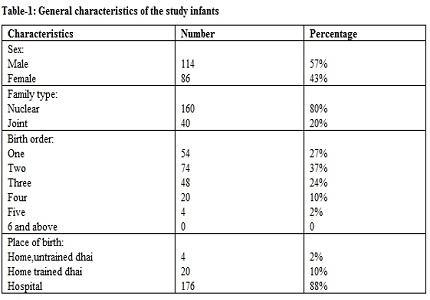A study of association between self feeding practices and nutritional status of infants in a rural population
Abstract
Background: Feeding practices determine the nutritional staus of infants. Infant and young child feeding practices include appropriate breastfeeding and complementary feeding practices. The impact of complementary feeding in the form of proper timing, quantity and quality of food on nutritional status is a matter of study in many research works. But nutrional stautus not only depends on type and amount of food but also on how its fed. Responsive feeding which includes encouraging the chlild to feed himself or herself also improves nutritional status.
Objective: To assess the impact of self-feeding practice on nutritional status of children.
Materials and Methods: A cross sectional study was done between December 2015 to January 2016 on 200 infants between 9 months to 1 year in field practice area of Sri Siddhartha Medical College Tumkur.
Results: Of the 200 infants who were studied, self feeding was initiated early (8 to 10 months) in 158 infants and late (after 10 months) in 42. The prevalence of stunting was significantly less in early self-feeding group (18.98%) compared to late self-feeding group (47.14%) with P value of <0.001. The prevalence of wasting was also found to be significantly less in early self-feeding group (37.9 %) compared to late self-feeding group (66.66%) with P value of <0.001.
Conclusion: There is a significant association between early self-feeding practices and better nutritional status of infants.
Downloads
References
2. Aboud FE, Shafique S,Akhter S. A Responsive Feeding Intervention Increases Children’s Self-Feeding and Maternal Responsiveness but Not Weight Gain. Journal of Nutrition.2009; 139: 1738–1743. [PubMed]
3. Hediger ML, Overpeck MD, Ruan WJ, Troendle JF et al. Early infant feeding and growth status of US-born infants and children aged 4-71 mo: analyses from the third National Health and Nutrition Examination Survey, 1988-1994. Am J Clin Nutr. 2000 Jul;72(1):159-67. [PubMed]
4. Fawzi WW, Herrera MG, Nestel P, el Amin A, Mohamed KA. A longitudinal study of prolonged breastfeeding in relation to child undernutrition. International Journal of Epidemiology 1998; 27:255–60. [PubMed]
5. PAHO, 37th Session of the Subcommittee on Planning and Programming of the Excecutive Committee, 2003.
6. PAHO, ProPAN: Process for the Promotion of Child Feeding, 2003.
7. Birch LL, Fisher JO. Development of eating behaviours among children and adolescents. Pediatrics 1998;101:539–49.
8. Bentley M, Gavin L, Black MM, Teti L. Infant feeding practices of low-income, African-American, adolescent mothers: an ecological, multigenerational perspective. Social Science and Medicine. 1999;49:1085–100. [PubMed]
9. Barton SJ. Infant feeding practices of low-income rural mothers.American Journal Maternal Child Nursing 2001;26:93–7. [PubMed]
10. Fisher JO, Birch LL, Smiciklas-Wright H, Picciano MF. Breast-feeding through the first year predicts maternal control in feeding and subsequent toddler energy intakes. Journal of American Diet Association 2000;100:641–6.
11. Francis LA, Hofer SM, Birch LL. Predictors of maternal child-feeding style: maternal and child characteristics. Appetite 2001;37:231–43. [PubMed]
12. Kannan S, Carruth BR, Skinner J. Infant feeding practices of Anglo American and Asian Indian American mothers. Journal of American College of Nutrition.1999;18:279–86.
13. Kesterton A J and Cleland J. Neonatal care in rural Karnataka: healthy and harmful practices, the potential for change. BMC Pregnancy and Childbirth 2009; 9:20. [PubMed]
14. DasS, BapatU , MoreN S , ChordhekarL , JoshiW and Osrin D. Prospective study of determinants and costs of home births in Mumbai slums. BMC Pregnancy and Childbirth 2010;10:38. [PubMed]
15. PAHO/WHO. Guiding principles for complementary feeding of the breastfed child. Washington, DC/Geneva, Switzerland: PAHO/WHO, 2004. [PubMed]
16. International Institute for Population Sciences (IIPS) and Macro International. 2007. National Family Health Survey (NFHS-3), 2005–06: India: Volume I. Mumbai: IIPS.
17. Gupta SB, Srivastava BC, Bhushan V and Sharma P. Impact of guidelines on breastfeeding appropriate for India, National the ICDS in UP. Indian Journal of Medical Research 1984; 79 : 615.
18. Ruel M, Levin CE, Armar-Klemusu M, Maxwell DG, Morris SS. Good care practices mitigate the negative effects of poverty and low maternal schooling on children’s nutritional status: evidence from Accara.World development report 1999; 27 : 1993-2009.

Copyright (c) 2016 Author (s). Published by Siddharth Health Research and Social Welfare Society

This work is licensed under a Creative Commons Attribution 4.0 International License.


 OAI - Open Archives Initiative
OAI - Open Archives Initiative


